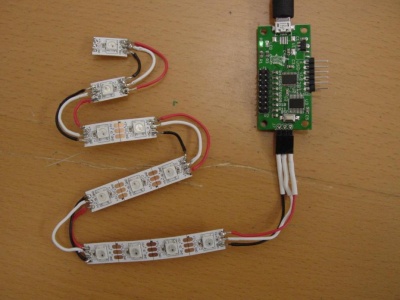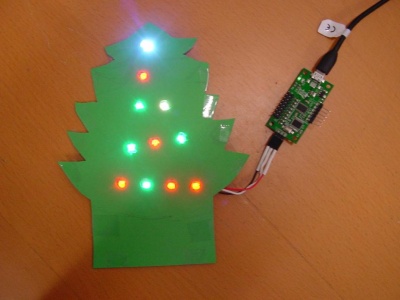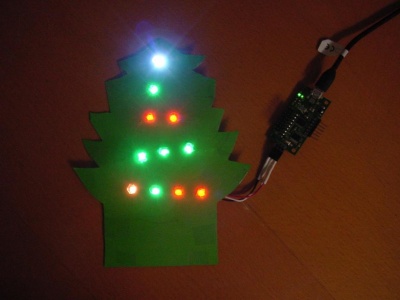Blog 24
Working with RGB leds on the WS2812
For Linux/Raspberry:
apt-get install ckermit
If you use and other device, or want to know more:
C-Kermit
For Windows users it's optional to use:
PuTTY
RGB lighted paper Tree
Hardware used:
Software used on my linux pc:
- C-kermit
Making the construction
The RGB leds:
On ////J7 a connector is added, also an cable from the J1 was connected on pin 15 with the second pin from J7. The image further on explains itself. You still have to look out, that you let the pointers point away from the usb ws2812.
Paper tree:
The paper tree is made by folding a green paper. On the folded green paper I put my RGB led connection. Around the RGB led I draw a Christmas tree. At the point every single RGB led were laying I put a dot with a pencil.
After that I cut the tree and put holes only on paper with the pencil dots. After that I used some scotch tape to bring it all together. The final result:
You can of course go all crazy with the tree by adding glitters and stuff like that.
The code
The c-program RGBTree.c can be downloaded: here.
What the code does in short is this: When starting up it will make the the top led (the peak) white. It will then read the for statement where it goes through all the leds under the peak. Every led will randomly get the color green or red. Then the script will keep fading the colors of the leds from to the opposite color. ( red to green or green to red )
The parts of the script that I will give some explanation:
Here I made a list of colors(if you also want other colors search for: color table):
#define WHITE 0xffffff #define YELLOW 0xffff00 #define RED 0x800000 #define GREEN 0x008000 #define BLUE 0x0000ff #define BLACK 0x000000
Because it's RGB ( red green blue ) the first ff is making the red led go to it's maximum. The middle ff is for green and the last for blue. It works in hexadecimals so you can lower or make the density higher or lower. And mix them so that you can get different colors as for example yellow.
Here the amount of time and steps in miliseconds is given for to make the fading go fluent.
int nfadesteps = 30;
int delayms = 30;
int interpolate (int c1, int c2, int shift, int pos, int end)
{
c1 >>= shift;
c2 >>= shift;
c1 &= 0xff;
c2 &= 0xff;
return c1 * (end-pos) / end + c2 * pos / end;
}
void fadeto (int pixnum, int col1, int col2)
{
int i;
int r, g, b;
for (i=0;i <= nfadesteps;i++) {
r = interpolate (col1, col2, 16, i, nfadesteps);
g = interpolate (col1, col2, 8, i, nfadesteps);
b = interpolate (col1, col2, 0, i, nfadesteps);
printf ("pix %d %06x\n", pixnum,
(r << 16) | (g << 8) | (b << 0));
usleep (delayms*1000);
}
}
int main (int argc, char **argv)
{
int nleds = 10;
int *pixels;
int pixnum, newcolor;
int i;
if (argc > 1)
nleds = atoi (argv[1]);
pixels = calloc (nleds, sizeof(int));
printf ("pix %d %06x\n", nleds, WHITE);
for (i=0;i < nleds;i++){
if (random () % 2 == 0)
pixels[i] = RED;
else
pixels[i] = GREEN;
printf ("pix %d %06x\n", i, pixels[i]);
}
while (1) {
pixnum = random () % nleds;
if (pixels[pixnum] == RED)
newcolor = GREEN;
else
newcolor = RED;
fadeto (pixnum, pixels[pixnum], newcolor);
pixels[pixnum] = newcolor;
}
exit (0);
}


